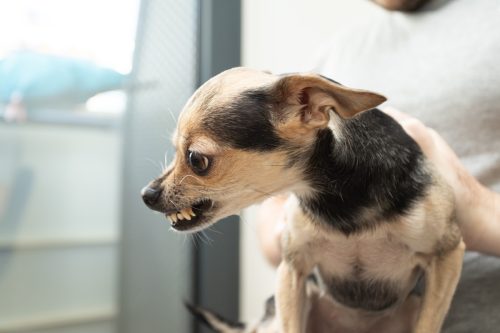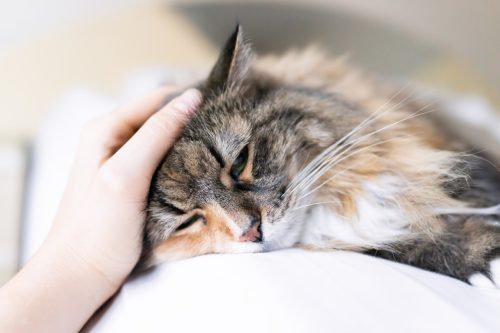7 Red Flags That Your Pets Need to Be Separated, Veterinarians Warn

Once you have one furry friend in your family, it’s hard not to want to add another. Unfortunately, having multiple animals in one home can present its own set of challenges. Some pets simply don’t get along with one another, which might mean you’ll need to keep them apart until you can consult a trainer. But how can you know for sure that your pets need to be kept apart? We talked to a few experts to get more insight on what pet owners should be looking out for. Read on for their seven red flags that mean your pets should be separated.
RELATED: Cesar Millan Says You Should Never Walk Behind Your Dog—Here’s Why.
1
Fixated eyes

Some dogs that have a strong prey drive will kill cats if given the chance, warns Alexandra Basset, CPDT-KA, lead trainer and behavior specialist at DogSavvy. That’s why it’s important to examine dogs’ eyes when there are cats around.
“If a dog is fixating on another creature (and won’t take its eyes off it) and flicks its tongue, these are warning signs it may be about to go into an arousal state (also known as a heightened state of energy), which could result in an actual attack,” she explains.
When a dog is in an arousal state, its eyes may appear bloodshot or whale-like, in that you can see the whites of them, according to Basset.
RELATED: I’m a Dog Trainer and I’d Never Own These 5 Breeds “Unless My Life Depended on It.”
2
Aggressive behavior

Another important red flag to watch out for is aggressive behavior, Sabrina Kong, DVM, experienced veterinarian and staff writer at WeLoveDoodles, tells Best Life.
“Aggression between pets can be a concerning issue, especially for small breeds,” she says. “It’s crucial to understand the root cause of the aggression and take appropriate action.”
3
Constant fleeing

Many pets love to wrestle, which is often harmless. But if one pet is always trying to get away during this playtime, it could be a sign that the other is getting too rough, according to Daniel Caughill, pet expert and co-founder of The Dog Dale.
“If you notice that one of your pets is visibly trying to get away from the other, it’s a good idea to put them in separate rooms,” he advises. “Once separated, both will be able to calm down, and there won’t be any risk of playful wrestling boiling over into something more violent.”
RELATED: Veterinary Workers Reveal the Dog Breeds They’re “Most Scared Of.”
4
Persistent bullying

Whether it’s a dog or a cat—no matter the size or breed—any pet can engage in bullying behavior. When that happens, it’s “essential to recognize and address this immediately,” according to Kong.
“Persistent bullying can lead to significant stress and anxiety for the victimized pet, impacting their overall well-being,” she explains. “As a veterinarian, I often advise pet owners to intervene by separating the bully from the victim and implementing positive reinforcement training to modify the bully’s behavior.”
5
Warning growls

Dogs will let their fellow pets know they don’t like them—so it’s important to keep an ear out for this, Caughill says.
“When your pets pass close to each other, listen for warning growls,” he recommends. “If you notice anything, it’s a good idea to separate your pets every time you leave the home, and you should avoid allowing them both to get into cramped spaces together, such as under the dining table.”
RELATED: Your Dog’s Tail-Wagging Could Be a Bad Thing—Here’s How to Tell.
6
Food dominance

Animals may try to assert their position in the household over other pets by dominating their food or water source, according to Courtnye Jackson, DVM, veterinarian and founder of The Pets Digest.
“If an owner notices that one pet is losing too much weight, they may want to monitor them while eating to see how they are interacting,” she says. “And if one pet is being food dominated, they might want to separate them during meal times.”
7
Chronic stress

Chronic stress is a “serious concern for pets and can have long-term effects on their health and behavior,” Kong warns. And that stress may come from conflict with other animals in the household.
“As a veterinarian, I emphasize the importance of recognizing the signs of chronic stress in pets, such as changes in appetite, excessive vocalization, or withdrawal from social interactions,” she says.